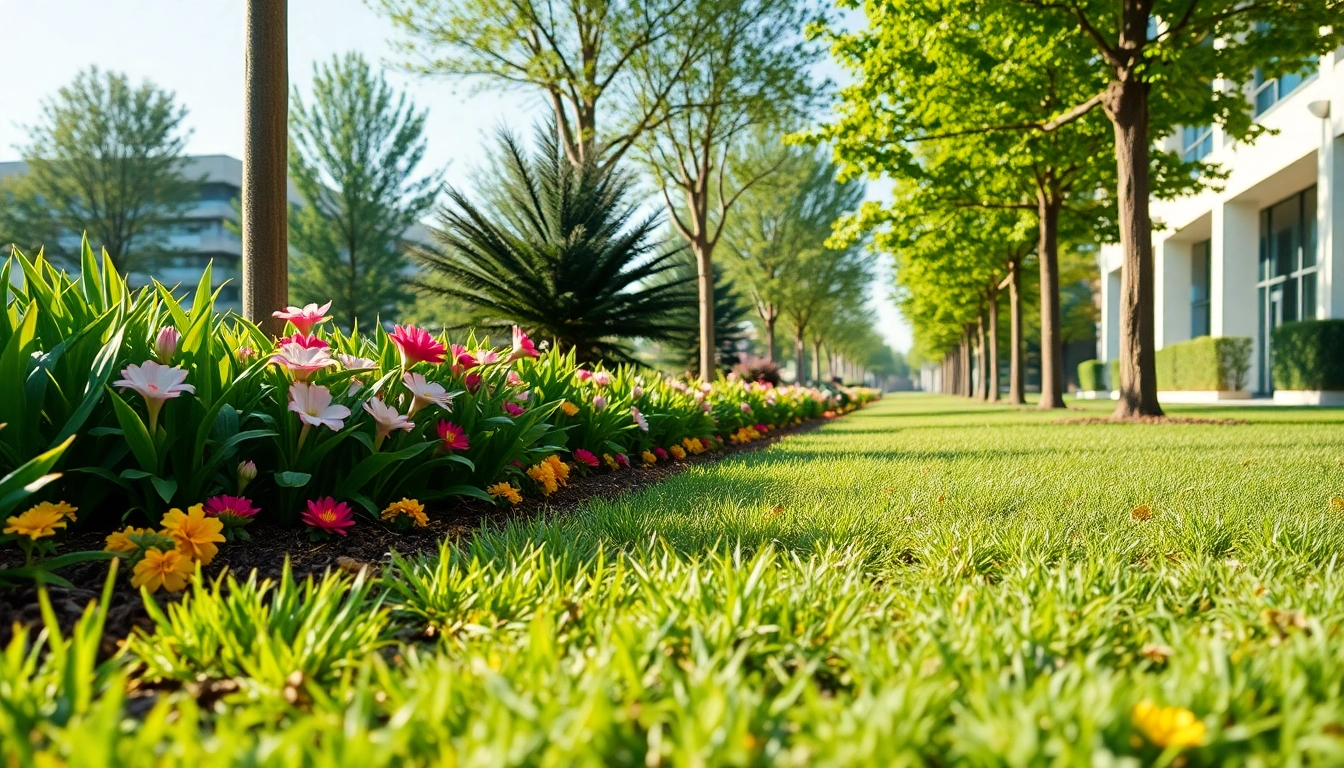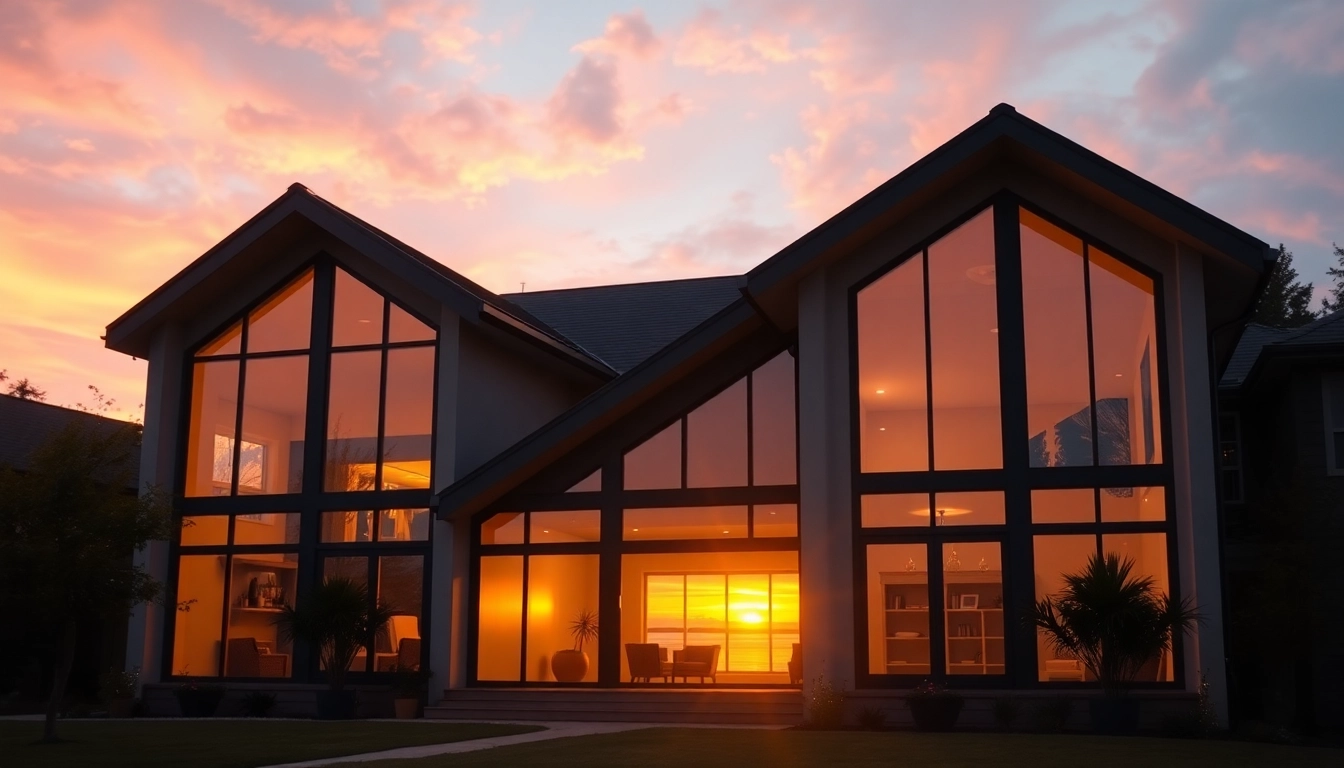Understanding Commercial Landscaping
Definition and Importance of Commercial Landscaping
Commercial landscaping refers to the design, installation, and maintenance of outdoor spaces specific to businesses, corporations, and other commercial environments. This professional service encompasses a range of activities including landscape design, management of green spaces, and aesthetic enhancements that not only beautify a property but also contribute to its overall functionality. The importance of commercial landscaping cannot be understated; well-designed landscapes enhance curb appeal, create a welcoming atmosphere, and can significantly impact client perceptions and employee satisfaction.
Key Services Offered by Commercial Landscaping Contractors
Commercial landscaping contractors provide a myriad of services tailored to meet the unique needs of businesses and organizations. Some of the key services include:
- Landscape Design and Installation: Creating visually appealing and functional outdoor spaces, including planting trees, shrubs, and flower beds.
- Maintenance Services: Regular upkeep to ensure that landscapes remain healthy and attractive, including mowing, pruning, weed control, and fertilization.
- Irrigation Systems: Designing and installing efficient watering systems that promote plant health while conserving water resources.
- Hardscaping: Incorporating non-plant elements such as patios, walkways, and retaining walls that enhance the landscape design.
- Sustainability Practices: Implementing eco-friendly landscaping practices which may include xeriscaping, the use of native plants, and sustainable landscape management practices.
Benefits for Businesses and Communities
The benefits of engaging with commercial landscaping contractors extend beyond mere aesthetics. Businesses can enjoy numerous advantages:
- Increased Property Value: A professionally maintained landscape can significantly enhance a property’s value.
- Improved Employee Morale: Well-designed outdoor spaces provide employees with a pleasant environment, which can lead to increased productivity.
- Environmental Benefits: Commercial landscapes contribute to biodiversity and help reduce urban heat, mitigate stormwater runoff, and improve air quality.
- Community Engagement: Thoughtful landscaping can foster a sense of community pride and ownership, encouraging social interactions.
Choosing the Right Commercial Landscaping Contractor
Factors to Consider in Selection
Selecting the right commercial landscaping contractor is an essential decision that can determine the success of your landscaping project. Several factors should be considered:
- Experience: Look for contractors with a proven track record and relevant experience in commercial landscaping projects.
- Portfolio: Review their past work to gauge their style, creativity, and quality of workmanship.
- Reviews and References: Seek testimonials from past clients and review platforms to understand their reputation.
- Licensing and Insurance: Ensure that they are appropriately licensed and insured to perform landscaping work in your area.
Evaluating Contractor Credentials and Experience
When fine-tuning your selection process, it’s vital to evaluate the credentials of potential contractors:
- Industry Certifications: Check for certifications from recognized industry organizations, which can be an indication of professionalism and expertise.
- Years in Business: Longevity in the industry often reflects stability and the ability to complete projects successfully.
- Specializations: Some contractors may specialize in specific types of landscaping, such as sustainable practices or hardscaping. Ensure their expertise aligns with your project’s needs.
Understanding Contracts and Services Offered
Before signing any contracts, it’s crucial to clearly understand the terms and services included:
- Scope of Work: Ensure the contract outlines exactly what services will be provided, including design, installation, and maintenance.
- Timeline: Confirm the project timeline and milestones to manage expectations.
- Payment Terms: Discuss payment structures and options, making sure all terms are transparent and agreed upon.
- Warranties and Guarantees: Understand any warranties offered for plants, materials, or services.
Design Trends in Commercial Landscaping
Popular Aesthetics and Themes
As the landscape industry evolves, so do the aesthetics associated with commercial landscaping. Understanding current trends can help businesses choose designs that resonate with clients and employees alike:
- Native Landscaping: Utilizing native plants that are well-adapted to the local environment promotes sustainability and reduces maintenance costs.
- Minimalist Designs: Clean lines, open spaces, and fewer plant types are becoming popular for modern corporate environments, emphasizing simplicity and elegance.
- Biophilic Design: Incorporating nature into urban settings, such as green walls or rooftop gardens, connects people with nature, improving well-being.
Environmental Sustainability Practices
With the growing concern for the environment, many commercial landscaping contractors are now prioritizing sustainability in their designs:
- Xeriscaping: This approach minimizes the need for irrigation by using drought-resistant plants and efficient landscape designs.
- Soil Health Initiatives: Contractors may focus on healthy soil practices, which support plant growth and minimize chemical use.
- Recycling and Reusing Materials: Green contracting practices incorporate the use of recycled materials in hardscaping and avoid waste generation.
Incorporating Technology in Landscape Design
Technology is increasingly playing a pivotal role in commercial landscaping, enabling more efficient project management:
- Design Software: Advanced design software allows contractors to create detailed plans and 3D models, providing clients with a visual representation of proposed landscapes.
- Smart Irrigation Systems: These systems use sensors to optimize water usage, reducing waste and promoting sustainability.
- Drones and GIS Technology: Some contractors use drones for aerial mapping and Geographic Information System (GIS) technologies for better planning and management of landscapes.
Maintenance Practices for Commercial Landscapes
Regular Care and Upkeep Needed
To ensure the longevity of a commercial landscape, regular maintenance is critical:
- Routine Inspections: Regular assessments can catch issues early, such as pest infestations or plant disease.
- Lawn Care: Regular mowing, edging, and fertilizing keep grass healthy and attractive.
- Winter Preparation: Preparing landscapes for winter weather includes mulching and protecting sensitive plants.
Seasonal Changes and Their Impact on Landscaping
Understanding the impact of seasonal changes can inform maintenance practices and promote healthy landscapes throughout the year:
- Spring: A time for planting and revitalization, landscaping tasks might include planting flowers, trimming, and fertilizing.
- Summer: Focus shifts to watering and pest management to sustain plant health during warmer months.
- Fall: This is the ideal time for preparing plants for winter, including mulching and cleaning up fallen debris.
- Winter: Some landscapes require additional care during dormancy, and planning for the spring can begin to ensure a seamless transition.
Hiring Help: When to Call Commercial Landscaping Contractors
While many businesses may handle minor landscaping tasks in-house, there are optimal times to engage professional contractors:
- Complex Projects: For large-scale installations that require expertise and manpower, it’s advisable to hire professionals.
- Time Constraints: Companies with limited staff or time may find it easier to engage experts for timely and efficient maintenance.
- Need for Specialized Knowledge: When facing specific challenges such as pest control or soil management, contractors can provide insights and solutions that in-house teams may lack.
Measuring Success with Commercial Landscaping
Metrics to Evaluate the Impact on Business
To assess the effectiveness of landscaping efforts, various performance metrics can be analyzed:
- Property Value Increases: Monitor any increases in property valuation associated with landscaping improvements.
- Customer Satisfaction Surveys: Surveying customers pre- and post-landscaping can help measure satisfaction levels and perceptions of the business.
- Employee Productivity Metrics: Evaluating employee performance and satisfaction before and after landscaping changes can highlight any positive effects.
Client Testimonials and Feedback Loops
Direct feedback from clients can serve as a qualitative measure of success:
- Follow-Up Calls: Regular check-ins with clients can provide insights on their satisfaction and identify any areas of improvement.
- Online Reviews: Encouraging clients to leave reviews can promote transparency and provide valuable testimonials for future clients.
Case Studies: Successful Commercial Landscapes
Highlighting successful case studies can serve as powerful examples of the positive impact of commercial landscaping:
- Corporate Campus Revitalization: A leading tech company revamped its outdoor spaces, integrating native plants and promoting employee wellness, resulting in a documented 15% increase in employee satisfaction.
- Retail Complex Transformation: A shopping center hired a landscaping contractor to create engaging outdoor spaces, which led to a 30% increase in foot traffic.
- University Green Spaces: A university implemented sustainable practices in its landscaping, enhancing not only aesthetics but also improving student engagement and retention.


